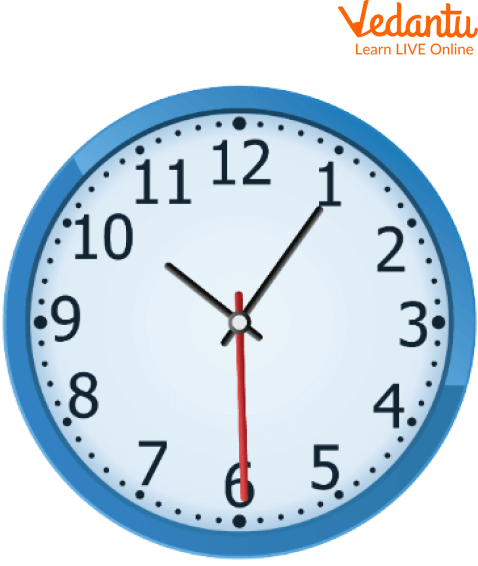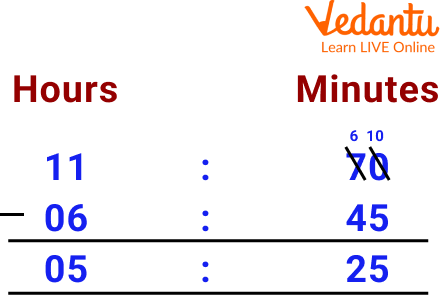




Introduction to Addition and Subtraction of time
Time plays a crucial role in our lives. We use it to measure how long something takes, how much time we have left, and how much time is left before an event.
Time addition and subtraction are two math topics frequently taught in schools. There are many ways to teach these topics, but one way is using the clock face. Time is the most important factor in math. It can quickly and accurately calculate the time required to complete a task. There are many ways to do this, but one of the most efficient methods is adding and subtracting time.
This section will look at various methods for adding and subtracting time. We'll also talk about some common mistakes people make when calculating the amount of time it takes for a task or project.

Clock
Time and its Basic Unit
We can define time as a period during which a certain event happens, has happened or is going to happen. It is a measurable quantity and is also infinite. Time is measured in seconds, minutes, hours, days, months, and years. There are many other smaller units of time, such as milliseconds and microseconds. The smallest time unit is 'Zeptosecond'.
How to Convert Between Hours, Minutes, and Seconds?
Conversion between hours, minutes, and seconds:
$\text { Time in seconds }=\text { time in minutes } \times 60=\text { time in hours } \times 3600$
Convert 30 minutes into seconds.
We know that 1 minute $=60$ seconds,
So if we had to calculate how many seconds make 30 minutes,
We multiply 30 by 60,
Therefore, the total number of seconds in 30 minutes is 1800 seconds.
$\text { Time in minutes }=\frac{\text { time in seconds }}{60}=\text { time in } \text { hours } \times 60$
Now, let us convert minutes and seconds into seconds for 40 minutes and 100 seconds.
We convert 40 minutes into seconds, $=40 \times 60$ seconds $=2400$ seconds.
Now add the 100 seconds,
$=2400+100 \text { seconds }=2500 \text { seconds }$
$\text { Time in hours }=\frac{\text { time in minutes }}{60}=\frac{\text { time in } \text { seconds }}{3600}$
Now, let us convert hours and minutes into minutes
Let's take the example of 8 hours and 30 minutes
8 hours 30 minutes
$=(8 \times 60)+30 \text { minutes }=480+30 \text { minutes }=510 \text { minutes }$
Addition of Time
Adding time in math is the process of adding distinct units of time such as hours, minutes, and seconds and then integrating them.
Steps to add time:
Adding time by hours and minutes is very simple if we know their conversion.
First, add all the hours of the two times.
Now add the minutes of the two given times.
Further write the time obtained in hours: minutes format.
For example, let us add the set of two times, 9:10 and 1:15. Adding hours 9 and 1 equals 10. Further, adding minutes 10 and 15 is equal to 25. Further writing the calculated hours and minutes together, we have 10:25.
In some cases, if the added minutes are more than 60, we cannot take it directly. Instead, we must convert that into hours by subtracting the additional minutes.
Let us see this with another example:
Add 7:45 and 3:25. Here, we have 7 + 3 = 10, and 45 + 25 = 70. These 70 minutes cannot be taken directly. We know that 1 hour = 60 minutes. The 70 minutes can be written as 60 minutes + 10 minutes or 1 hour and 10 minutes. Therefore the time is 11 hours and 10 minutes or 11:10.
Subtraction of Time
The subtraction of time is almost the same as the addition of time.
For this, we follow some simple steps.
First, subtract the hours, and then subtract the minutes.
Further, write the resultant answer of hours and minutes.
Let us look at this with a simple example. Let us subtract 5:45 from 7:55. First, let us subtract the hours 7 - 5 = 2; then, we can now subtract the minutes 55 - 45 = 10. The result can be written together as 2:10.
Addition and Subtraction of Time Word Problems
Here, questions related to the word problem of addition and subtraction of time are given, which are like this;
Q 1. Add 38 minutes 40 seconds and 35 minutes 15 seconds.
Ans: First add the seconds 40 + 15 = 55 seconds
Second add the minutes, 38+35= 73 minutes
Convert, 73 minutes= 60+13= 1 hour 13 minutes
Because 1 hour = 60 minutes
Q 2. Add 26 minutes 35 seconds and 14 minutes 15 seconds.
Ans: First, add the seconds 35 + 15 = 50 seconds
Second, add the minutes, 26+14= 40 minutes
Q 3. Subtract 6:45 a.m. from 12:10 p.m.
Ans: We observe here that 45 minutes is more than 10 minutes. So, for carrying on subtraction, we need to borrow minutes from 12 hours and give to 10 minutes. By borrowing 60 minutes from 1 hour, we have 12 hours, 10 minutes is equal to 11 hours, 60 minutes + 10 minutes, or 11 hours and 70 minutes. Now, we have 70 minutes which is more than 45 minutes. So, we proceed with the following subtraction.

Subtraction of time
Q 4. Subtract 42 minutes 55 seconds and 12 minutes 15 seconds.
Ans: First, add the seconds 55 - 15 = 40 seconds.
Second add the minutes, 42-12= 30 minutes
Addition and Subtraction of Time Word Worksheet
Here Worksheet related to the word problem of addition and subtraction of time are given, which are like this;
Q 1. 40 minutes 15 seconds + 12 minutes 25 seconds.
Ans: 52 Minutes 40 Seconds
Q 2. Subtract 18 minutes 29 seconds from 24 minutes 15 seconds
Ans: 5 minutes 46 seconds
Q 3. Subtract 10 hours 50 minutes from 12 hours 45 minutes.
Ans: 1 hour 55 minutes
Q 4. Add 25 minutes 45 seconds and 15 minutes 25 seconds.
Ans: 41 minutes 10 seconds
5. 32 Minutes 15 Seconds - 12 Minutes and 5 Seconds
Ans. 20 Minutes 10 Seconds
Summary
If you want to know how to add or subtract time in math, you will first need to know what the different units of measure are. The units of measure used for time are hours, minutes and seconds. The conversion table of time is a necessary tool for various mathematical calculations. Conversion of time either involves multiplication or division to change the unit. This means that you must multiply if you take a larger unit and convert it to a smaller one. But if you take a smaller unit and convert it to a larger one, you must divide it. There are two ways to add time in math: hours or minutes. To subtract time, we have to use the same procedure as subtracting it - by subtracting hours or minutes. This article will summarise the addition and subtraction of time in math.
FAQs on Addition and Subtraction of Time
1. What are the basic steps to add time in hours and minutes?
To add time, you should follow two simple steps. First, add the minutes together. Second, add the hours together. If the total number of minutes is 60 or more, you need to convert them. Since 60 minutes equals 1 hour, subtract 60 from the minute total and add 1 to the hour total. For example, to add 2 hours 40 minutes and 1 hour 30 minutes, you get 3 hours and 70 minutes, which you then convert to 4 hours and 10 minutes.
2. How do you subtract time when no borrowing is needed?
Subtracting time is similar to subtracting regular numbers when the minutes you are subtracting are smaller. First, subtract the minutes from the minutes. Then, subtract the hours from the hours. For example, to subtract 1 hour 15 minutes from 3 hours 45 minutes, you subtract 15 from 45 to get 30 minutes, and subtract 1 from 3 to get 2 hours. The result is 2 hours and 30 minutes.
3. What is the method for subtracting time when you need to borrow?
When the minutes you are subtracting are larger than the starting minutes, you must borrow from the hour column. For instance, to subtract 1 hour 50 minutes from 3 hours 20 minutes, you cannot take 50 from 20. So, you borrow 1 hour from the 3 hours, which leaves you with 2 hours. That 1 hour is converted into 60 minutes and added to the original 20 minutes, giving you a total of 80 minutes. Now you can subtract: 80 - 50 = 30 minutes, and 2 - 1 = 1 hour. The final answer is 1 hour and 30 minutes.
4. Why do we borrow or carry over at 60 when calculating time, instead of 100?
This is because time operates on a base-60 system, not a base-10 system like our usual numbers. There are 60 seconds in a minute and 60 minutes in an hour. When you borrow 1 hour, you are actually borrowing 60 minutes. Similarly, when you add minutes and they total more than 59, you convert every 60 minutes into one hour to carry over. This is the most important difference between adding regular numbers and adding time.
5. How can you calculate the time duration that crosses over from a.m. to p.m.?
To find the duration between an a.m. time and a p.m. time, it's easiest to use 12:00 noon as a reference point. First, calculate the time from the start time to 12:00 p.m. Then, calculate the time from 12:00 p.m. to the end time. Finally, add these two durations together. For example, to find the time from 9:00 a.m. to 2:00 p.m., it's 3 hours from 9 a.m. to 12 p.m., and 2 hours from 12 p.m. to 2 p.m. The total duration is 3 + 2 = 5 hours.
6. What are some real-world examples of using addition and subtraction of time?
We use time calculations constantly in our daily lives. Here are a few examples:
- Planning your day: Figuring out what time you need to leave home to get to school or an appointment on time.
- Cooking and baking: Adding up cooking and resting times for a recipe. For example, bake for 35 minutes, then let it cool for 15 minutes.
- Travel: Calculating your total travel time, including layovers between flights or bus journeys.
- Homework and hobbies: Tracking how long you spend on different tasks to manage your schedule better.
7. What is a common mistake to avoid when adding time?
A very common mistake is forgetting to convert minutes into hours when the sum is 60 or more. For example, when adding 3 hours 50 minutes and 2 hours 20 minutes, some might incorrectly write the answer as 5 hours 70 minutes. Because 70 minutes is more than an hour, it must be converted. The correct approach is to recognise that 70 minutes is 1 hour and 10 minutes. This extra hour is added to the 5 hours, making the final, correct answer 6 hours and 10 minutes.
8. How is calculating time with a 12-hour clock different from a 24-hour clock?
The main difference is the need for a.m. and p.m. in the 12-hour system. This can make subtraction across noon or midnight tricky. The 24-hour clock (or military time) simplifies this. For instance, subtracting 8:00 (8 a.m.) from 17:00 (5 p.m.) is a simple calculation (17 - 8 = 9 hours). In the 12-hour system, you have to work around 12 p.m. to get the same result. The 24-hour system treats the entire day as a single block of time, which removes the a.m./p.m. complexity.









